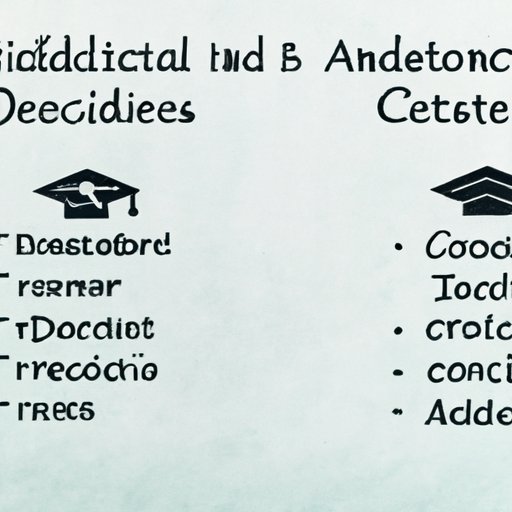
Introduction
Choosing to pursue an Associate’s Degree is an exciting time for students who are eager to start their journey toward higher education. However, navigating the credit requirements needed for an Associate’s Degree can be daunting, especially for first-timers. This article aims to provide a comprehensive guide to help students understand what they need to do to successfully meet their credit requirements for an Associate’s Degree.
A Beginner’s Guide to Understanding Credit Requirements for an Associate’s Degree
An Associate’s degree is a two-year degree program that helps students gain fundamental knowledge and skills in a particular field of study. It is considered a stepping stone for students who plan to continue pursuing higher education, such as a bachelor’s degree.
Credit requirements are a significant part of any degree program, and the same stands true for an Associate’s degree. The number of credits required will vary depending on the program, but typically, students are required to complete anywhere between 60 to 72 credits.
Credits are essentially the measurement of how much time and effort students put into their coursework outside of the classroom. They are calculated based on the number of hours a course is in session, the complexity of the coursework, and the amount of work required for assignments and projects.
There are two types of credits, including:
- Major requirements: These are credits that are specific to your degree program. They are courses that are directly related to your major’s field of study and are necessary for students to gain a deep understanding of the subject matter.
- General education requirements: These are credits that are not specific to your degree program but are necessary to gain a well-rounded understanding of various disciplines, such as math, science, language, and writing.
Breaking Down Different Associate Degree Credit Requirements Across Fields
The credits needed to earn an Associate’s degree will vary depending on the field that students choose to study. Some degree programs may require more credits than others due to the complexity of the coursework, hands-on experience, and skills needed to complete the program successfully.
For instance, Associate’s degree programs in healthcare, engineering, or law enforcement typically require more credits than programs like photography or graphic design. This is because the former fields require a more extensive and specialized curriculum to ensure students are well-prepared for their chosen career path.
Here is a brief overview of the credit requirements for some popular Associate’s Degree fields:
- Healthcare: Typically, healthcare programs require between 80 to 90 credits, including coursework such as anatomy, physiology, pharmacology, and patient care.
- Business: Business programs typically require between 60 to 70 credits, including coursework such as accounting, finance, marketing, and management.
- Engineering: Engineering programs typically require between 70 to 80 credits, including coursework such as mathematics, physics, and computer science.
Mistakes to Avoid When Trying to Meet Associate Degree Credit Requirements
When it comes to meeting credit requirements for an Associate’s degree, students may become overwhelmed and make common mistakes. These mistakes can lead to delays in completing their degree program and additional costs, so it’s best to avoid them if possible.
Some common mistakes include:
- Not planning courses appropriately.
- Choosing courses that don’t fulfill the degree program’s requirements.
- Not taking enough courses to meet the credit requirements on time.
- Not seeking help or guidance from academic advisors when needed.
To avoid these mistakes, students should prioritize planning and organization. They should also regularly consult with their academic advisors to ensure they are on track and taking the courses that will fulfill degree requirements.
Navigating Transfer Credits to Meet Associate Degree Credit Requirements
Transferring credits to meet Associate’s degree requirements can be a strategic way for students to get ahead. Transfer credits refer to coursework that students have already completed at another accredited institution that can be applied to their current degree program.
Students looking to transfer credits must ensure the courses they have completed fulfill the same or similar requirements as the courses in their current degree program. They will also need to provide their transcripts from previous institutions to evaluate their coursework’s applicability to their current degree program.
There are two types of transfer credits:
- Direct equivalents: Courses that are identical or similar in subject matter and content to courses offered at the student’s current institution.
- General transfer credits: Courses that do not have a direct equivalent at the student’s current institution but can be applied to their general education requirements or electives.
To successfully transfer credits, students should plan ahead and research their current institution’s requirements for transfer credits. They should also ensure that the courses they complete at other institutions are accredited and recognized by their current institution.
Why Meeting Associate Degree Credit Requirements Is Key for Career Success
Meeting credit requirements for an Associate’s degree is critical for a student’s future career success. These requirements signify that students have successfully completed the coursework necessary to gain fundamental knowledge and skills in their field of study.
Students who successfully meet their credit requirements can benefit from:
- Increased job opportunities and higher salary potential.
- A higher likelihood of being accepted to higher education programs.
- The ability to obtain licenses and certifications in their field of study.
On the other hand, students who are unable to meet credit requirements may face disadvantages, such as:
- Limited job opportunities compared to those who have met credit requirements.
- Difficulty in transferring to higher education programs.
- A delay in obtaining required licenses and certifications.
Real Students Share How They Met Their Associate Degree Credit Requirements
To get an idea of how real students successfully met their credit requirements, we’ve gathered some interviews with students who have recently completed their Associate’s degree programs.
Here are some strategies they used to meet their credit requirements:
- Creating a detailed plan of the courses they needed to take each semester.
- Utilizing online courses or distance learning to take courses during non-traditional hours.
- Working with academic advisors to ensure they were completing the necessary coursework on time.
- Looking for opportunities to test out of courses for which they already had knowledge or experience.

Associate Degree Credit Requirements: A Comparison of Online and Traditional Degree Programs
Online and traditional programs are two primary ways for students to earn their Associate’s degree. Both have their own unique advantages and disadvantages, and the same holds true for credit requirements.
Typically, online programs have more flexible credit options, allowing students to complete their coursework at their own pace. Traditional programs have structured schedules for coursework, making it easier for students to plan their credit requirements.
Here is a brief overview of the credit requirements for both types of programs:
- Online programs: Online programs typically require the same amount of credits as traditional programs, which is between 60 to 72 credits.
- Traditional programs: Traditional programs typically require the same amount of credits as online programs, which is between 60 to 72 credits.
It’s essential to research both types of programs and their respective credit requirements to determine which option is best suited for your needs and schedule.
Conclusion
Meeting credit requirements for an Associate’s degree is a significant step toward career success. It signifies that students have successfully completed a specific amount of coursework necessary to gain fundamental knowledge and skills in their field of study.
To meet credit requirements, students must plan accordingly, research transfer credits and their current institution’s requirements, and avoid common mistakes that can delay the completion of their degree program.
We hope this guide has provided helpful insights into navigating the credit requirements for an Associate’s degree. Remember, academic advisors are always available to provide guidance and ensure students are on track to meet their goals.





